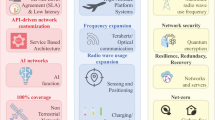Abstract
This paper proposes an algorithm to design rate-adaptive irregular LDPC codes with improved Bit error rate (BER) performance. It focuses on achieving better BER results for higher order coding rates which are in high demand for 5G mobile communications. The algorithm generates a parity check matrix based on the message block size. The encoding complexity of the irregular LDPC code is comparatively reduced due to the proposed parity check matrix. Simulation results compare the BER performances of irregular LDPC codes for various code rates and modulation schemes with the Parity check matrix (PCM) generated by the proposed algorithm. The BER performance of improved irregular LDPC code is analyzed in a real-time scenario using Software Defined Radio platform as well.







Similar content being viewed by others
References
Al-Safar, D., & Edwards, R.M., (2016) A software defined radio comparison of received power with Quadrature Amplitude Modulation and Phase Modulation schemes with and without a Human. In IEEE European conference on antennas and propagation (EuCAP), ISBN 978-8-8907-0186-3, Davos, Switzerland.
Chung, S. Y., David Forney, G., Richardson, T. J., & Urbanke, R. (2001). On the design of low-density parity-check codes within 0.0045 dB of the Shannon limit. IEEE Communications Letters,47(2), 58–60.
Deergha Rao, K. (2015). Channel coding techniques for wireless communications. Berlin: Springer.
Develi, I., & Kabalci, Y. (2016). A comparative simulation study on the performance of LDPC coded communication systems over Weibull fading channels. Journal of Applied Research and Technology,14(2), 101–107.
Fan, J., Xiao, Y., & Kim, K. (2008). Design LDPC codes without cycles of length 4 and 6. Journal of Electrical and Computer Engineering, Research Letters in Communications,2008, 354137.
Gamage, H., Rajatheva, N., & Latvaho, M. (2017). Channel coding for enhanced mobile broad band communication in 5G systems. In IEEE European conference on networks and communications, 978–1–5386–3873, Oulu, Finland.
Gilbert, W. J., & Nicholson, W. K. (2004). Modern algebra with applications. Hoboken: Wiley.
IEEE 802.16e (2005). Air interface for fixed and mobile broadband wireless access system. IEEE P802.16e/D 12 Draft.
IEEE 802.11.n. (2006). Wireless LAN medium access control and physical layer specifications: enhancement higher throughput. IEEE P802.16n/D1.0.
Jethanandani, H., & Aravind, R. (2003). Message-passing decoding for low-density parity-check codes. In 9th national conference on communications, NCC2003, (pp. 20–24). Chennai, India: Indian Institute of Technology Madras.
Jose, R. and Ameenudeen, P. E. (2015). Channel coding using low density parity check codes in AWGN. In 2nd international conference on emerging trends in technology and applied science(ICETTAS’15), (no. 2, pp. 32–37). Kottayam, Kerala, India.
Li, J., Narayanan, K. R., & Georghiades, C. N. (2004). Product accumulate codes: a class of codes with near-capacity performance and low decoding complexity. IEEE Transactions on Information Theory,50(1), 31–46.
Luby, M. G., Mitzenmacher, M., Shokrollahi, M. A., & Spielman, D. A. (2001). “Improved low-density parity-check codes using irregular graphs. IEEE Transactions on Information Theory,47(2), 585–598.
Minal, M., Madankar, & Ashtankar, P. S. (2016). Performance analysis of BPSK modulation scheme for different channel conditions. In IEEE Students’ conference on electrical, electronics and computer science (SCEECS)978-1-4673-7919-9, Bhopal, India.
Mitchell, D. G. M., Lentmaier, M., Pusane, A. E., & Costello, D. J., Jr. (2016). Randomly Punctured LDPC Codes. IEEE Journal on Selected Areas in Communications,34(2), 408–421.
Mosleh, M. F. (2011). Evaluation of low density parity check codes over various channel types. Engineering and Technology Journal,29(5), 961–967.
Rashidpour, M., & Jamali, S. H. (2005). Design and analysis of simple irregular LDPC codes with finite-lengths and their application in CDMA systems. Wireless Communications and Mobile computing,5(3), 305–318. https://doi.org/10.1002/wcm.224.
Richardson, T., & Urbanke, R. (2001). Efficient encoding of low-density parity-check codes. IEEE Transactions on Information Theory,47(2), 638–656.
Singh, J. P., & Singh, S. (2017). Implementation of OFDM and other multicarrier modulations on SDR. In International conference on signal processing, communication, power and embedded system (SCOPES), 978-1-5090-4620-1, (pp. 1937–1940).
Vila Casado, A. I., Weng, W.-Y., Valle, S., & Wesel, R. D. (2009). Multiple-rate low-density parity-check codes with constant block-length. IEEE Transactions on Communications,57(1), 75–83.
European Telecommunications Standards Institute (ETSI). Digital VideoBroadcasting (DVB) Second generation framing structure, channel coding and modulation systems for Broadcasting; EN 302 307 VI. 1.1.
Yang, R. (2008). LDPC codes for flat rayleigh fading channels with channel side information. IEEE Transactions on Communications,56(8), 1207–1213.
Zhu, Y., & Chakrabarti, C. (2009). Architecture-aware ldpc code design for multi-processor software defined radio systems. IEEE Transactions on Signal Processing,57(9), 3679–3692.
Author information
Authors and Affiliations
Corresponding author
Additional information
Publisher's Note
Springer Nature remains neutral with regard to jurisdictional claims in published maps and institutional affiliations.
Rights and permissions
About this article
Cite this article
Mahalakshmi, R., Bhuvaneshwari, P.V., Tharini, C. et al. A Novel Algorithm to Design Rate-Adaptive Irregular LDPC Codes. Wireless Pers Commun 113, 453–468 (2020). https://doi.org/10.1007/s11277-020-07223-3
Published:
Issue Date:
DOI: https://doi.org/10.1007/s11277-020-07223-3




